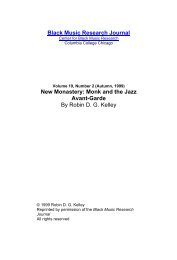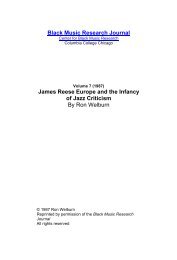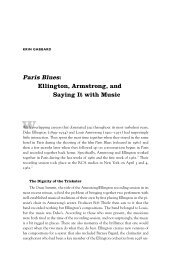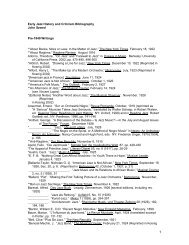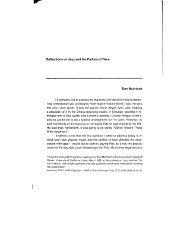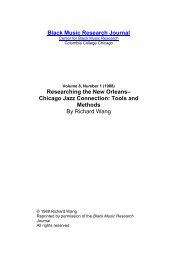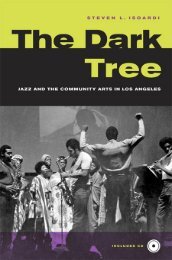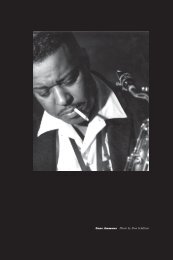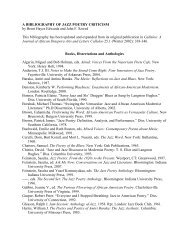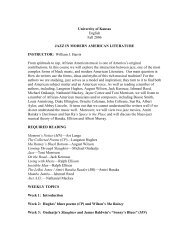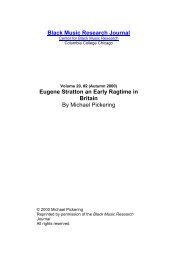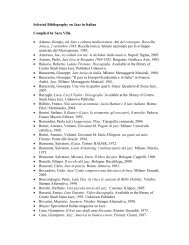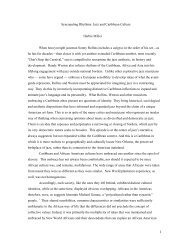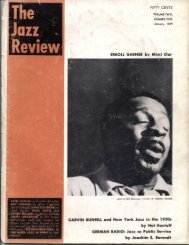The Jazz Review - Jazz Studies Online
The Jazz Review - Jazz Studies Online
The Jazz Review - Jazz Studies Online
Create successful ePaper yourself
Turn your PDF publications into a flip-book with our unique Google optimized e-Paper software.
with anything better. <strong>The</strong> result is<br />
a stylistic vacuum, in which Madison<br />
Avenue jargon ("lusty satire showcasing<br />
Green's incomparable dirty<br />
tone") jostles the newspaperman's<br />
adjective-hunting, which seems so<br />
often a sort of condescension ("a<br />
dozen sides which remain among the<br />
most exhilarating small group work<br />
on disks"). <strong>The</strong> jazzmakers themselves<br />
are treated with a standard<br />
brand of tight-lipped sentimentality.<br />
But of course it is difficult to avoid<br />
the Ernest tone, even if it estranges<br />
the subject instead of bringing it<br />
closer.<br />
Along with what is weak or irritating,<br />
the book offers much that<br />
is good, especially when the musicians<br />
speak for themselves. Baby<br />
Dodds and Roy Eldridge sound off<br />
at length. Hentoff shepherds critics,<br />
promoters, musicians, and Lester<br />
Young through a most illuminating<br />
panel discussion of Lester Young.<br />
Charles Edward Smith contributes<br />
articles on Pee Wee Russell, Teagarden,<br />
and Billie. <strong>The</strong>se pieces are<br />
true evocations of personality: every<br />
rambling paragraph, moreover, exhibits<br />
the respect and affection of<br />
Smith for what he is dealing with.<br />
And isn't this first requisite of<br />
readable criticism?<br />
<strong>The</strong> <strong>Jazz</strong> Makers was published last<br />
year by Rinehart and now reappears<br />
(with some different photographs)<br />
as a reprint from the Grove<br />
Press, which already offers Hodeir's<br />
valuable and annoying book. It is<br />
encouraging to find a line of paper<br />
backs hospitable to books on jazz,<br />
but sad to acknowledge that so few<br />
merit reprinting.<br />
—Glenn Coulter<br />
J A M SESSION, edited by Ralph J.<br />
Gleason, G. P. Putnam's Sons, 1958<br />
Under the accurately loose-sounding<br />
title, Jam Session and subtitle<br />
"An Anthology of <strong>Jazz</strong>," jazz writer,<br />
reviewer, critic and fas I'm sure he'd<br />
insist on including) still-enthusiastic<br />
veteran jazz fan Ralth Gleason has<br />
compiled an extremely varied thirtysix<br />
piece collection concerned with as¬<br />
pects or people of jazz. All but one<br />
are non-fiction—the exception is<br />
Elliott Grennard's highly effective<br />
"Sparrow's Last Jump," which deals<br />
with a musician who flips, quite literals,<br />
at a recording session, a story<br />
that has been described as an almostnon-fictional<br />
account of a Charlie<br />
Parker session. Like almost any<br />
other anthology in the world, this<br />
volume is clearly designed to be read<br />
in fairly small chunks, or left on the<br />
bedside table. Much of it appears to<br />
have been originally written for light<br />
reading—brief personality sketches,<br />
musicians' reminiscences — although<br />
there are several efforts at serious<br />
critical or analytical writing. On this<br />
level—which is a completely respectable,<br />
and in this case quite enjoyable<br />
level—this is generally a very<br />
successful collection.<br />
If the foregoing seems a somewhat<br />
negative way of speaking well of a<br />
book, it is just because I feel there is<br />
some need to keep the reader from<br />
being deceived by the books' own<br />
presentation of itself. For we have<br />
here another instance of the great<br />
war between publishers and writers<br />
(or anthologists), the manifestation<br />
of which is in the jacket blurb claiming<br />
far more that the man who put<br />
the book together thought of doing,<br />
and the main potential victim of<br />
which is the purchaser of the book.<br />
Mr. Gleason, who is literate and nonpretentious,<br />
notes in his introduction<br />
that he could not make this a winnowing<br />
of the best jazz pieces he has<br />
read in the past twenty years, largely<br />
because so much that seemed good at<br />
the time has turned out on re-inspection<br />
to have grown dated or<br />
corny. So all he claims for the hook<br />
is that it is "an interesting collection<br />
of articles about interesting people,<br />
interesting aspects of jazz and ex¬<br />
planations of it." He notes with re¬<br />
gret that there are no articles about<br />
Duke, Louis, or Bird, but points out<br />
that the book couldn't hope to be allinclusive.<br />
When he takes such an ap¬<br />
proach, it would be unfair to fault<br />
him very much for not including the<br />
work of a single current serious jazz<br />
writer (excepting only himself, and<br />
none of Ralph's several pieces here<br />
are intended as 'serious' writing),<br />
and I would even be inclined to let<br />
him get away with limiting a selection<br />
entitled "<strong>The</strong> Coming of Modern<br />
<strong>Jazz</strong>" to only three selections (one<br />
of which is from <strong>The</strong> Partisan <strong>Review</strong>—and<br />
reads that way; and another<br />
by the splenetically argumentative<br />
and inadequatelv informed<br />
Henry Pleasants). But why, oh why,<br />
does the jacket blurb have to insist<br />
that within these pages is ". . . the<br />
finest writing on jazz that has appeared<br />
during the past two decades<br />
... in pieces by and about the jazz<br />
world's greatest critics, performers<br />
and writers"? Why are we informed<br />
that this anthology seeks "to bring<br />
into perspective the whole body of<br />
... a new and serious writing" about<br />
jazz? It's not really Cleason's fault,<br />
but too much caveat emptor is too<br />
much.<br />
This gripe aside, the book has lots<br />
of good fun in it, as previously indicated.<br />
<strong>The</strong>re are some examples of<br />
the rich, ripe Boston prose of George<br />
Erazier; there is that Grennard story<br />
(which I had never read before and<br />
was grateful for) ; there is an old<br />
and interesting Bruce Lippincott<br />
piece that is sort of a theoretical dissection<br />
of the jam session; there are<br />
excerpts from the spoken recordings<br />
of Jelly Roll Morton and Bunk Johnson;<br />
two good items by the late Otis<br />
Ferguson (one of the under-appreciated<br />
early jazz writers); an intriguing<br />
fragment about prohibition<br />
Chicago by Art Hodes, who was<br />
there; Lillian Ross' classic (if you<br />
know how seriously not to take it)<br />
New Yorker yarn on the first clambake<br />
at Newport. <strong>The</strong>re are also lesser<br />
items by less able or interesting<br />
people; and there is a mite too much<br />
of the editor himself (eight selections,<br />
some quite good, but about<br />
three that don't seem worth it: one<br />
on the up-coming of "Rhythm and<br />
Blues" that is rather dated; a 1946<br />
piece on the career of Nat "King"<br />
Cole; and a 1956 detailing of how<br />
active things were in jazz on the<br />
West Coast).<br />
All in all, a good though certainly<br />
not indispensable book, and at its<br />
fully comparable price ($4.95,) a<br />
hetter buy than a lot of twelve-inch<br />
LPs that are issued nowadays. But<br />
if you take this book home, don't forget<br />
to throw away the wrapper before<br />
anyone can get at it.<br />
—Orrln Keepnews<br />
T H E HANDBOOK OF JAZZ, bv Barry<br />
Ulanov. Viking Press, 1957<br />
Somewhere in the vast United<br />
States, it seems there is an institution<br />
called Barnard College, and in this<br />
college there dwells an assistant professor<br />
of the English language called<br />
Barry Ulanov. I state these facts as<br />
categorically as possible because people<br />
who read Ulanov's Handbook will<br />
think there has been some mistake.<br />
<strong>The</strong> Handbook is a pedestrian<br />
hotchpotch of old-hat anecdote and<br />
smug presumption badly written. <strong>The</strong><br />
professor says "flatted" when he<br />
means "flattened" and still believes<br />
after all those years at college that<br />
the flute is a reed instrument. He is<br />
also a past master of the construction<br />
of those wooly sentences which, like<br />
the lights of 'Broadway, look pretty<br />
so long as you don't attempt to read<br />
them.<br />
Early in the book, the professor<br />
tells us that Lester Young's style is<br />
"close-noted." whatever that is supposed<br />
to mean. And then we learn,<br />
later on, that Lester's style features<br />
the use of "sustained open notes"—a<br />
trulv professional example of nonsense<br />
contradicting itself. After this<br />
kind of stuff, the reader is hardly



